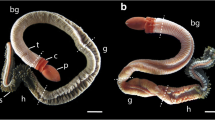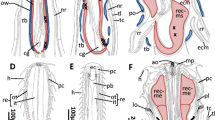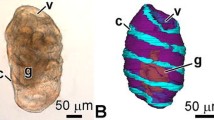Abstract
Juvenile and adult Cossura pygodactylata Jones 1956 from the White Sea were studied using confocal laser scanning microscopy, light microscopy, scanning and transmission electron microscopy. Transformations of the anterior musculature and digestive tract during ontogenesis were investigated. The early juveniles were shown to be lecithotrophic; their pharyngeal cavities were not connected to the intestines, which contained yolk granules. The juveniles bore prototrochs, which are used for movement, although juveniles had parapodial musculature similar to that of the adults. The juveniles presumably inhabit the upper semi-liquid layer of the silt. The muscles of the prostomium and circumbuccal complex change dramatically during ontogenesis. The ultrastructure of the buccal tentacles is redescribed. The tentacles consist of outer ciliated epithelial cells and an inner cylinder formed by epithelio-muscle cells. The blood sinus is situated between the central cylinder and the epithelium. Both juveniles and adults have developed circulatory systems. The whole dorsal vessel forms the heart with walls that consist of cells with circular cross-striated muscular fibres. The inner lumen is occluded by the heart body which is formed by a single row of cells that are tightly pressed together and connected by adherens junctions along their anterior and posterior surfaces. They contain granules and vesicles and bear numerous processes on the outer surface. The heart body most likely has a secretory haemopoetic function. A hypothetical mechanism of protraction and retraction of the buccal tentacles is suggested, and the participation of muscle contraction and relaxation in these movements is described. It is proposed that the protraction of the tentacles is provided by cell rigidity and increases in the blood volume in the tentacles blood sinuses. The development of the circulatory system is likely related to the need to keep the tentacles exposed during feeding while the anterior part of the body cavity is filled with muscle cell processes and there is no coelomic liquid flow. The proposed mechanism of feeding inside the sediment contrasts with that of surface feeding suggested by Tzetlin (Mém Mus Natl Hist Nat 162:137–143, 1994).









Similar content being viewed by others
References
Bachelet G, Laubier L (1994) Morphology, ecology and juvenile development of Cossura pygodactylata Jones (Polychaeta, Cossuridae) in Arcachon Bay, SW France, with a reassessment of the geographical distribution of C. pygodactylata and C. soyeri Laubier. Mém Mus Natl Hist Nat 162:355–369
Braunbeck T, Dales RP (1984) The role of the heart-body and of the extravasal tissue in disposal of foreign cells in two polychaete annelids. Tissue Cell 16(4):557–563
Dorgan KM, Jumars PA, Johnson BD, Bordeaux BP (2006) Macrofaunal burrowing: the medium is the message. Oceanogr Mar Biol Annu Rev 44:85–121
Filippova A, Purschke G, Tzetlin AB, Müller MC (2005) Reconstruction of the musculature of Magelona cf. mirabilis (Magelonidae) and Prionospio cirrifera (Spionidae) (Polychaeta, Annelida) by phalloidin labeling and cLSM. Zoomorphology 124:1–8
Filippova A, Purschke G, Tzetlin AB, Müller MC (2010) Musculature in polychaetes: comparison of Myrianida prolifera (Syllidae) and Sphaerodoropsis sp. (Sphaerodoridae). Invertebr Biol 129:184–198
Fransen M (1988) Coelomic and vascular systems. In: Westheide W, Hermans CO (eds) The ultrastructure of Polychaeta. Microfauna Mar. vol 4. Gustav Fischer Verlag, Stuttgart, New York, pp 199–213
Green KJ, Getsios S, Troyanovsky S, Godsel LM (2010) Intercellular junction assembly, dynamics, and homeostasis. Cold Spring Harb Perspect Biol 2(2):a000125
Jones ML (1956) Cossura pygodactylata, a new annelid from San Francisco Bay (Polychaeta: Cirratulidae). J Wash Acad Sci 46:127–130
Kennedy GY, Dales PR (1958) The function of the heart-body in polychaetes. J Mar Biol Assoc UK 37(1):15–31
Purschke G (1993) Structure of the prostomial appendages and the central nervous system in the Protodrilida (Polychaeta). Zoomorphology 113(1):1–20
Radashevsky VI (2012) Spionidae (Annelida) from shallow waters around the British Islands: an identification guide for the NMBAQC Scheme with an overview of spionid morphology and biology. Zootaxa 3152:1–35
Rouse GW, Pleijel F (2001) Polychaetes. Oxford University Press, Oxford
Rouse GW, Tzetlin AB (1997) Ultrastructure of the body wall and gametogenesis in Cossura cf. longocirrata (Cossuridae Polychaeta). Invertebr Reprod Dev 32(1):41–54
Tzetlin AB (1994) Fine morphology of the feeding apparatus of Cossura sp. (Polychaeta, Cossuridae) from the White Sea. Mém Mus Natl Hist Nat 162:137–143
Zhadan AE, Vortsepneva EV, Tzetlin AB (2012) Redescription and biology of Cossura pygodactylata Jones, 1956 (Polychaeta: Cossuridae) in the White Sea. Invertebr Zool 9:115–125
Zhadan A, Vortsepneva E, Tzetlin A (2014) Three-dimensional reconstruction of the musculature of Cossura pygodactylata Jones, 1956 (Annelida: Cossuridae). Zool Anz 253(3):181–191
Acknowledgments
This study was supported by grant from the Russian Foundation of Basic Research, Grant No. 15-04-05875 (the collection of the material) and No. 13-04-00078 (transmission and scanning electron microscopy investigations). The confocal laser scanning microscopy investigations were supported by Russian Scientific Foundation, Grant 14-50-00029. The electron microscopical investigations were performed at User Facilities Center of M.V.Lomonosov Moscow State University and at the Institute for Biology of Inland Waters of the Russian Academy of Sciences.
Author information
Authors and Affiliations
Corresponding author
Additional information
Communicated by A. Schmidt-Rhaesa.
Rights and permissions
About this article
Cite this article
Zhadan, A., Vortsepneva, E. & Tzetlin, A. Ontogenetic development and functioning of the anterior end of Cossura pygodactylata Jones, 1956 (Annelida: Cossuridae). Zoomorphology 134, 509–521 (2015). https://doi.org/10.1007/s00435-015-0282-7
Received:
Accepted:
Published:
Issue Date:
DOI: https://doi.org/10.1007/s00435-015-0282-7




